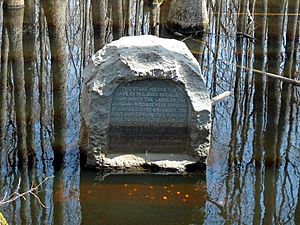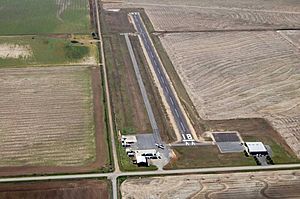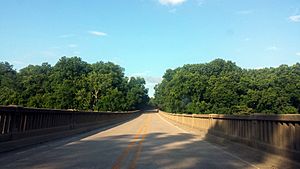Monroe County, Arkansas facts for kids
Quick facts for kids
Monroe County
|
|
|---|---|
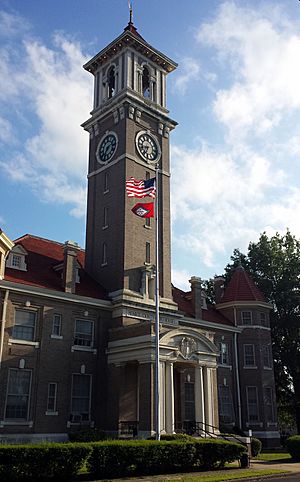
Monroe County Courthouse in Clarendon
|
|
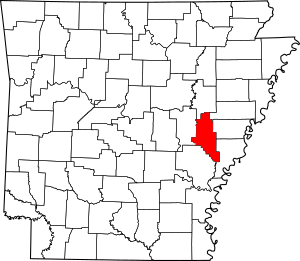
Location within the U.S. state of Arkansas
|
|
 Arkansas's location within the U.S. |
|
| Country | |
| State | |
| Founded | November 2, 1829 |
| Named for | James Monroe |
| Seat | Clarendon |
| Largest city | Brinkley |
| Area | |
| • Total | 621 sq mi (1,610 km2) |
| • Land | 607 sq mi (1,570 km2) |
| • Water | 14 sq mi (40 km2) 2.3%% |
| Population
(2020)
|
|
| • Total | 6,799 |
| • Estimate
(2023)
|
6,512 |
| • Density | 10.948/sq mi (4.227/km2) |
| Time zone | UTC−6 (Central) |
| • Summer (DST) | UTC−5 (CDT) |
| Congressional district | 1st |
Monroe County is located in the Arkansas Delta in the U.S. state of Arkansas. The county is named for James Monroe, the fifth President of the United States. Created as Arkansas's 20th county on November 2, 1829, Monroe County is home to two incorporated towns and three incorporated cities, including Clarendon, the county seat, and Brinkley, the most populous city. The county is also the site of numerous unincorporated communities and ghost towns.
Occupying only 621 square miles (161,000 ha), Monroe County is the 22nd smallest county in Arkansas. As of the 2020 Census, the county's population was 6,799. Based on population, the county is the fifth-smallest county of the 75 in Arkansas. Located in the Arkansas Delta, the county is largely flat with fertile soils. Historically covered in forest, bayous, swamps, and grasslands, the area was cleared for agriculture by early European-American settlers who used enslaved African Americans to do the work and to cultivate cotton. It is drained by the Cache River, Bayou DeView, and the White River. Three large protected areas preserve old growth bald cypress forest, sloughs and wildlife habitat in the county: Cache River National Wildlife Refuge (NWR), Dagmar Wildlife Management Area and White River NWR and provide places for hunting and fishing.
Interstate 40 is the only Interstate highway in Monroe County, crossing the county from east to west through Brinkley, the largest city. The county also has three United States highways (U.S. Route 49 [US 49], US 70, and US 79) and twelve Arkansas state highways run in the county. A Union Pacific Railroad line crosses the county from southwest to northeast.
Contents
History
Settlement in Monroe County began when Dedrick Pike settled where the Cache River enters the White River in 1816. The settlement was named Mouth of the Cache, and a post office by that name was opened years later. The community renamed itself Clarendon in 1824 in honor of the Earl of Clarendon. Monroe County was established under the Arkansas territorial legislature in 1829, and the county seat was established at Lawrenceville where a jail and courthouse were erected. A ferry across the White River came in 1836, and in 1857 the county seat was moved to Clarendon, Arkansas, with the new brick courthouse nearly finished at the outbreak of the American Civil War. The county sent five units into Confederate service, and the Union captured Clarendon in 1863 and destroyed the city. Martial law was established for four years after the war as guerilla warfare continued and the county struggled to rebuild. The Union had completely dismandled the brick courthouse and shipped the bricks to De Valls Bluff. The Monroe County Sun was established in 1876.
It was at a site near the intersection of Monroe, Phillips, and Lee counties that surveys began shortly after the United States had completed the Louisiana Purchase. From wetlands in what would become southern Monroe County, approximately 900,000 square miles (2,300,000 km2) of land would be explored after President James Madison commissioned a survey of the purchase area. The point was commemorated in 1961 by the Arkansas General Assembly as part of Louisiana Purchase State Park.
Geography
The county is located in the Arkansas Delta, one of the six primary geographic regions of Arkansas. The Arkansas Delta is a subregion of the Mississippi Alluvial Plain, which is a flat area consisting of rich, fertile sediment deposits from the Mississippi River between Louisiana and Illinois. Large portions of Monroe County are also within the Grand Prairie, a subdivision of the Arkansas Delta known today for rice farming and aquaculture. According to the U.S. Census Bureau, the county has a total area of 621 square miles (1,610 km2), of which 607 square miles (1,570 km2) is land and 14 square miles (36 km2) (2.3%) is water.
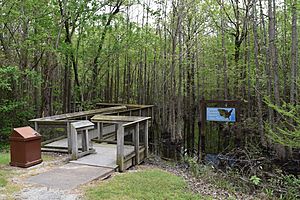
Prior to settlement, Monroe County was densely forested, with bayous, sloughs, and swamps crossing the land. Seeking to take advantage of the area's fertile soils, settlers cleared the land to better suit row crops. Although some swampland has been preserved in the conservation areas like the Cache River NWR and White River NWR, and some former farmland has undergone reforestation, the majority (52 percent) of the county remains in cultivation. Another large land use in Monroe County is the Cache River NWR and White River NWR, owned by the United States Fish and Wildlife Service.
The county is located approximately 73 miles (117 km) east of Little Rock and 88 miles (142 km) west-southwest of Memphis, Tennessee. Monroe County is surrounded by six other Delta counties: Woodruff County to the north, St. Francis County to the northeast, Lee County and Phillips County to the east, Arkansas County to the southwest, and Prairie County to the west.
Hydrology
Water is an extremely important part of Monroe County's geography, history, economy, and culture. The many rivers, streams, ditches, sloughs and bayous crossing the county have featured prominently since prehistoric times, when Native American tribes such as the Quapaw constructed burial mounds at Indian Bay in extreme southern Monroe County (today preserved as Baytown Site). The White River brought early prosperity to the county during white settlement due to its use as a navigable river. Control of the White River lead to military action in the county during the Civil War, including a gunboat battle at Clarendon in 1864. The Flood of 1927 damaged much of the county's settlements along the White, and inundated Clarendon when the levees protecting the city failed on April 20. Conservation efforts by leaders in the county lead to the creation of federal and state protected areas around the Cache and White beginning in 1935 and continuing to expand to this day.
The White River, one of Arkansas's most important rivers, is the county's major hydrologic features. The White forms the southwestern boundary of the county with Arkansas County. The Cache River runs on the west side of Monroe County, partially forming its border with Prairie County. Both the Cache River and Roc Roe Bayou empty into the White near Clarendon. Bayou De View runs through the north part of the county and meets the Cache north of Dobbs Landing.
National protected areas
Demographics
| Historical population | |||
|---|---|---|---|
| Census | Pop. | %± | |
| 1830 | 461 | — | |
| 1840 | 936 | 103.0% | |
| 1850 | 2,049 | 118.9% | |
| 1860 | 5,657 | 176.1% | |
| 1870 | 8,336 | 47.4% | |
| 1880 | 9,574 | 14.9% | |
| 1890 | 15,336 | 60.2% | |
| 1900 | 16,816 | 9.7% | |
| 1910 | 19,907 | 18.4% | |
| 1920 | 21,601 | 8.5% | |
| 1930 | 20,651 | −4.4% | |
| 1940 | 21,133 | 2.3% | |
| 1950 | 19,540 | −7.5% | |
| 1960 | 17,327 | −11.3% | |
| 1970 | 15,657 | −9.6% | |
| 1980 | 14,052 | −10.3% | |
| 1990 | 11,333 | −19.3% | |
| 2000 | 10,254 | −9.5% | |
| 2010 | 8,149 | −20.5% | |
| 2020 | 6,799 | −16.6% | |
| 2023 (est.) | 6,512 | −20.1% | |
| U.S. Decennial Census 1790–1960 1900–1990 1990–2000 2010 |
|||
2020 census
| Race | Num. | Perc. |
|---|---|---|
| White | 3,538 | 52.04% |
| Black or African American | 2,751 | 40.46% |
| Native American | 30 | 0.44% |
| Asian | 28 | 0.41% |
| Pacific Islander | 7 | 0.1% |
| Other/Mixed | 259 | 3.81% |
| Hispanic or Latino | 186 | 2.74% |
As of the 2020 United States Census, there were 6,799 people, 3,333 households, and 1,974 families residing in the county.
Communities
Cities
- Brinkley
- Clarendon (county seat)
- Holly Grove
Towns
Townships
Townships in Arkansas are the divisions of a county. Each township includes unincorporated areas; some may have incorporated cities or towns within part of their boundaries. Arkansas townships have limited purposes in modern times. However, the United States Census does list Arkansas population based on townships (sometimes referred to as "county subdivisions" or "minor civil divisions"). Townships are also of value for historical purposes in terms of genealogical research. Each town or city is within one or more townships in an Arkansas county based on census maps and publications. The townships of Monroe County are listed below; listed in parentheses are the cities, towns, and/or census-designated places that are fully or partially inside the township.
Infrastructure
Aviation
Monroe County is home to three public own/public use general aviation (GA) airports. Each airport is used largely for agricultural spraying operations. The Clarendon Municipal Airport located southwest of Clarendon and northwest of Roe along Highway 33. For the twelve-month period ending August 31, 2015, the facility saw 26,000 general aviation operations. Frank Federer Memorial Airport in southeast Brinkley had 22,000 GA operations in the twelve-month period ending August 31, 2015. Holly Grove Municipal Airport located east of Holly Grove on Highway 146 is also a small rural airport. For the twelve-month period ending August 31, 2015, the facility saw 22,000 general aviation operations.
Major highways
 Interstate 40
Interstate 40 U.S. Highway 49
U.S. Highway 49 U.S. Highway 70
U.S. Highway 70 U.S. Highway 79
U.S. Highway 79 Highway 1
Highway 1 Highway 17
Highway 17 Highway 33
Highway 33 Highway 39
Highway 39 Highway 86
Highway 86 Highway 146
Highway 146 Highway 238
Highway 238 Highway 241
Highway 241 Highway 302
Highway 302 Highway 316
Highway 316 Highway 362
Highway 362 Highway 366
Highway 366
Transit
Intercity bus service to the county is provided by Jefferson Lines, which has a stop in Brinkley.
Utilities
The Arkansas Department of Health is responsible for the regulation and oversight of public water systems throughout the state. Monroe County contains six community water systems: Brinkley Waterworks, Clarendon Waterworks, Holly Grove Waterworks, Roe Waterworks, United Water Association and East Monroe County Water Users. Brinkley Waterworks has the largest retail population (4,281), followed by Clarendon (1,640), and Holly Grove (1,010). All community water systems in Monroe County use groundwater as their source of raw water, except East Monroe County Water Users, who purchases all water from Brinkley.
Notable person
- Sheffield Nelson, the Arkansas Republican National Committeeman and his party's gubernatorial nominee in 1990 and 1994, was born in 1940 in Monroe County.
See also
 In Spanish: Condado de Monroe (Arkansas) para niños
In Spanish: Condado de Monroe (Arkansas) para niños


